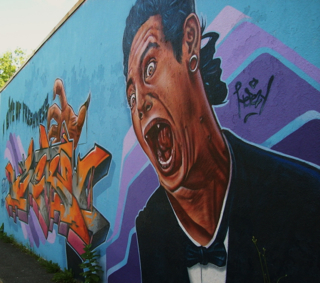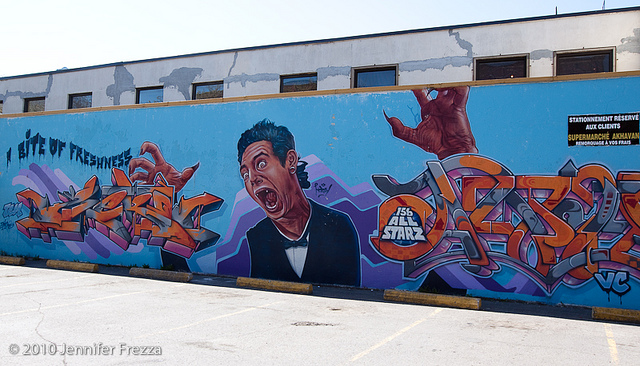Among the things that make for a humanized and humanizing neighbourhood, urban art may not be at the top of the list, but it is certainly on the list. Otherwise put, urban art has the potential to illuminate and enrich our lives as we navigate our streets and sidewalks, from vegetable shop to Dépanneur, from church to community centre.
I’ve been living in NDG for some 13 years now and urban art (beyond the usual, all-too-common tags) is a recent adventure for the neighbourhood. In the past 5 years, 3 new murals have gone up – part of an effort to both staunch the endless flow of graffiti/tags and to enrich the face of the neighbourhood. Suffice it say, we’ve got a ways to go in the realm of urban art. I thought this might be a an interesting subject for a few blog posts, particularly since the missional identity of the church requires that we understand and interpret our neighbourhoods, and participate in them in meaningful ways.
The first mural that comes to mind is, it is safe to say, rather banal. Here is a farmer’s field; safe little animals; nursery school colours. It is the sort of thing that is offensive to no one, and says absolutely nothing about community, food production, culture, or nature. (I’ll come back to the question of why it has been covered with tags.)
This mural “graces” the side wall of an amazing Persian market about three blocks from the church I serve, down on Sherbrooke Street West – Marché Akhavan. Aside from the non-descript airplane banner, there is almost nothing that connects the mural to the market. Nothing of Persian culture; nothing of immigrant life; nothing of the fraught urban-rural relationship. It is a mural that says almost nothing
But there may be a reasonable explanation for the banality of this mural. You see, in the weeks before nursery-room colours came to “grace” the wall of Akhavan, a decidedly more provocative mural had been freshly painted on that wall. Here it is (this picture is copyrighted by Jennifer Frezza and can be found here, on Flickr).
At some level it’s not hard to understand why this mural was painted over within just a few weeks. When I parked with my young kids to pick up a few things at Akhavan (and had to leave them in the van to run in quickly) I intentionally parked facing away from the mural, so they wouldn’t have to look at it and I wouldn’t have to explain it. Presumably I wasn’t the only one who found it problematic – it was gone within a few weeks, painted over.
There’s little doubt that graffiti artist who did this work is talented. The graffiti “word art” on either side of the centre-piece vampire is particularly well done from my point of view (very much the amateur urban art critic). The colouring is great, and the “technological” styling in the graffiti is really well done. The illustration of the vampire is also ok, in a technical sense. Finally there is also an attempted playfulness in the “bite of freshness comment,” which is presumably a play on the fresh fruits/veggies theme of the market.
 However, from my point of view (and presumably for those who complained), the problem with the peace is the appearance of the vampire itself – its imposing nature, fangs, bite marks on the neck, and nails. What does it mean? What does the presence of a vampire on the side of a Persian market, mean? How does it connect with the lives and experiences of NDGers. It is a bracing and threatening image, and with no narrative that could give it meaning for those navigating this part of the city. For little kids, which was my initial concern, this image would also likely be perceived as threatening, and not much more.
However, from my point of view (and presumably for those who complained), the problem with the peace is the appearance of the vampire itself – its imposing nature, fangs, bite marks on the neck, and nails. What does it mean? What does the presence of a vampire on the side of a Persian market, mean? How does it connect with the lives and experiences of NDGers. It is a bracing and threatening image, and with no narrative that could give it meaning for those navigating this part of the city. For little kids, which was my initial concern, this image would also likely be perceived as threatening, and not much more.
Back to the original, banal mural of the countryside. Why is it covered with tags when taggers will usually respect the presence of a mural by not covering it with tags? I suspect it is because the taggers find the countryside, primary-colour mural offensive – the original was in the style of underground-now-mainstream urban art, and thus to their liking. The vampire may be a familiar in the ‘world’ of some of these taggers, even if it is not at all central to the imagination and culture of the vast majority in the neighbourhood. But the country-side mural is in no way in the style of urban art – it is in no way edgy or thoughtful.
So in the end, no one is happy.
Is there nothing to be found between banal and offensive. Presumably the market erred on the side of caution in the wake of a customer protest about the first mural. Unhappy customers and commerce do not mix – and they learned their lesson. But does commerce really have to descend to the utterly banal and conventional? All too often the answer is yes. Say nothing, and do nothing that might raise questions or unsettle our assumptions. Just put up a pretty/banal picture.
Is there a distinctly theological approach to all of this? Not much more, perhaps, than to return to the original point. Within a theological vision, the city is a place of life and hope and tension and grief – and a place where the grace of Christ comes to us. Our neighbourhoods, infrastructure, and urban art can remind us this, interpret it, mirror it back to us, and aid is in embodying this reality. Not to say that this is easy. Creativity never is.


